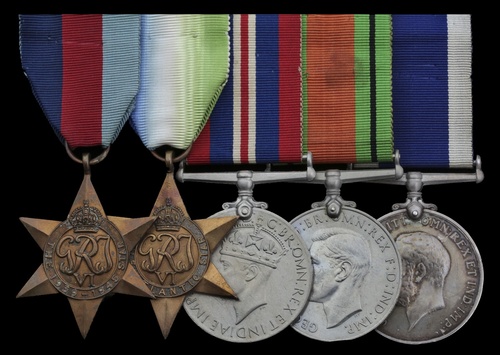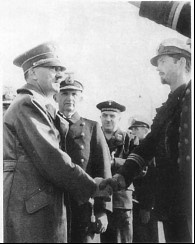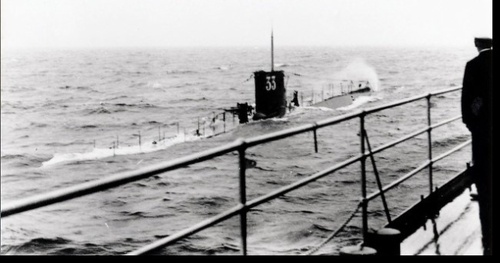Auction: 22002 - Orders, Decorations and Medals
Lot: 102
'The U-33 had left Wilhelmshaven on 5 February 1940 under Kapitanleutnant Hans von Dresky and a crew of forty. Her daring, almost suicidal task, which had been ordered by Hitler himself, was to lay mines in one of the Allies most valuable seaways, the River Clyde. Karl Dönitz himself visited Wilhelmshaven to see the U-boat off.
During the early hours of Sunday, 11 February 1940, Dresky told his Chief Engineer, Fritz Schilling, his plan. He wanted to be in a good mine laying position within the estuary before the sun came up. Then he planned to submerge and settle the U boat on the seabed until the evening when he hoped it would be safe to come to the surface again. After laying the mines during Sunday night and Monday morning, he hoped to escape to the relative safety of the Atlantic before dawn on Tuesday 13 February. But before any mines could be laid, Dresky's well thought out plan began to go wrong … '
The 'Halcyon-class' website sets the scene in what became a significant action in which vital components of the Enigma machine were captured by H.M.S. Gleaner in February 1940.
A Second World War campaign group of five awarded to Stoker 1st Class A. H. Kingwell, Royal Navy, who was present aboard H.M.S. Gleaner in a spectacular night action in the Firth of Clyde in the early hours of 12 February 1940
Having caught sight of U-33's periscope in her searchlights, Gleaner delivered three separate depth charge attacks, forcing her foe to the surface to face several rounds of 4-inch gunfire for good measure
The destruction of a U-boat in the early months of the war was a welcome achievement but the real prize was the discovery of assorted Enigma machine components - recovered from the uniform pockets of one of U-33's survivors: they may not have broken the secrets of 'Enigma' but they did provide the boffins at Bletchley Park with an early boost in cracking the most important code of them all
1939-45 Star; Atlantic Star; Defence and War Medals 1939-45; Royal Navy L.S. & G.C., G.VI.R., 1st issue (K. 57726 A. H. Kingwell, Sto. 1, H.M.S. P-40), minor edge bruise to last, generally very fine or better (5)
Alfred Henry Kingwell was born at Ivybridge, Devon on 20 September 1900 and entered the Royal Navy as an acting Stoker in August 1919.
By the outbreak of hostilities in September 1939 - and having been awarded his L.S. & G.C. Medal in January 1935 - he was serving as a Stoker 1st Class in the Halcyon-class escort H.M.S. Gleaner. And he remained likewise employed until April 1941.
Unravelling Enigma - an important first step
In that period Gleaner made a significant contribution to the war effort, capturing, as she did, valuable components from an Enigma machine. The action in question took place in the early hours of 12 February 1940, when the U-33 was ordered to lay mines in the Firth of Clyde.
The Halcyon-class website - http://www.halcyon-class.co.uk/ - takes up the story:
'The U 33 was making headway along on the surface during the early hours of Monday, 12 February, when the four lookouts on the bridge spotted a mysterious silhouette coming towards them out of the darkness. It was a ship travelling in the opposite direction to the U boat. Fortunately for the Germans, the blacked out vessel passed the U boat some distance away. Nevertheless, the lookouts on the bridge held their breath as they and Dresky watched it steam past.
Shortly after this, the Chief Engineer, Fritz Schilling, climbed the ladder inside the conning tower to talk to Dresky on the bridge. He could not have arrived at a worse moment. For Schilling was just in time to see what he took to be a British destroyer coming towards them. Seconds later Dresky shouted out, "Alarm", and he and all the lookouts jumped down the conning tower, as the U boat lurched forward into an emergency dive. The British ship which Schilling had spotted was not a destroyer. It was H.M.S. Gleaner, a converted survey ship in Britain's anti submarine fleet. It was the same ship which had sailed past the U boat shortly before. No one on Gleaner had seen the U 33 when the two ships had passed each other for the first time. But at about 2.50 a.m. on 12 February Gleaner's hydrophone set operator heard a suspicious noise which sounded to him like a diesel engine …
Gleaner's captain, Lieutenant Commander Hugh Price, and the officer on duty on Gleaner's bridge, swiftly gave the order for the ship to be turned around. As the range between the two vessels lessened, Gleaner's searchlights were switched on and the British lookouts caught sight of a white object which, they said, could have been the spray made by a periscope gliding through the water. It quickly disappeared. But by this time, Gleaner's asdic sonar equipment had locked onto the U 33. At 3.53 a.m. the British ship dropped its first pattern of depth charges …
The explosion of the depth charges jarred the U boat, and all the men who were lying in their bunks found themselves pitched unceremoniously onto the floor. At the same time there was a terrifying bang, louder than anything any of the men had ever heard before. It stunned and deafened them, and they found themselves staring up at the U boat ceiling, as if by doing so they might be able to tell whether more depth charges were about to rain down on top of them. No one panicked. However, one of the more experienced officers turned to Max Schiller, who at eighteen was the youngest man on board, and said, "Come here, Schiller. Can you sit down beside me. I'm a married man. I've got children to think about. It would help me if you could keep me company." Schiller obliged, grateful that he could calm himself by bringing comfort to someone else. The danger was underlined by the order to put on escape apparatus. All the men had been shown during their training how to escape from a sinking submarine. They had practised in a specially constructed tank. But they found themselves wondering whether they would survive long enough to escape. Or would they just feel one final terrifying explosion before all their faculties were switched off?
Shortly after the first explosions the U boat hit the seabed. But that only worsened their situation. The depth-meter was showing that they had come to a stop a paltry thirty six metres beneath the surface. As Dresky took stock in the control room, reports were coming in from fore and aft. One of the motors would not work, the lights were out, so the crew was having to make do with the dimmer emergency lighting, and many of the instruments were broken. Most ominously of all, water was beginning to leak into the boat.
At first Dresky allowed the U boat to remain on the seabed. But between 4 and 5 a.m. two more batches of depth charges exploded around them. At this point Dresky asked Schilling what action they could take. Schilling at first recommended that they should attempt to slip away under the water. But when he attempted to move the U boat, using subtle applications of pressurised air to remove some of the water inside the diving tanks, he found that it was stuck on the seabed. He eventually came to the conclusion that the only way out was to blow all the water out of the tanks, a manoeuvre which he hoped would take the U 33 up to the surface. However, he scoffed at the helmsman's view that they should then immediately abandon ship in order to save the crew's lives. Schilling still hoped that they would be able to creep away without being seen by the British warship. Dresky agreed, but it was at this point that their views began to diverge. Dresky's agreement was half-hearted. He was very pessimistic about their chances of escaping, given that they were still in British waters with dawn just hours away …
At 5.22 a.m. Schilling gave the order for the U 33's tanks to be blown, and the U-boat began to ascend towards the surface. As the conning tower appeared above the waves the hatch was thrown open. Before giving the command to abandon ship, Dresky could have consulted with Schilling one more time to see if there was a chance that the U boat could have carried them out of trouble above or below the water line. Schilling says that he tried to discuss what could be done with Dresky, but he gave up when he realised that the order to abandon ship had already been given. While he was speaking to Dresky, men were already clambering up the conning tower so that they could leap down into the sea.
At the same time as commanding everyone to abandon ship, Dresky also told his engineers to set the fuses for the explosives which had already been placed around the interior of the U-boat. However, the fuses were hastily extinguished after one of the engineers realised that they would go off before all the crew were out of the boat. In the struggle to evacuate the U boat, the fact that the fuses had been extinguished, and new fuses lit, appears not to have been mentioned to Schilling. That would explain why, when the explosives failed to go off quickly, first Schilling and then Dresky climbed back down the conning tower in a desperate, and heroic, attempt to ensure not only that the fuses were lit, but also that as many vents and hatches as possible were opened. They met up once again at the top of the conning tower, whereupon Dresky asked Schilling to go below once again to see if something could be done to make the U 33 sink more quickly. Schilling was about to refuse, when a wall of flame swept up the conning tower, and he felt a sharp blow on his left shoulder. At first he thought that he had been hit by a shell fired by Gleaner. Only later did he discover that it was the conning tower ladder which had struck him as the force of the explosion lifted it bodily out of the tower.
After the explosives went off, the gallant Dresky, who had lost the mouthpiece attached to his life jacket in the explosion, and the equally courageous Schilling jumped into the freezing water to join the other members of the crew who were still waiting to be picked up by the circling British ship. As the U-boat sank, Dresky called out to his men to give three cheers for the U 33. For many of the crew who were swimming around him, it was the last time they saw him alive.
But that was not the end of the story. The final act in the drama had yet to be played out, an act which revolved around the Enigma cipher machine wheels. These were put in the pockets of certain members of the U 33's crew who were supposed to drop them into the sea once they were clear of the U-boat. According to one survivor, two of the men did as they were told. Their wheels were lost forever in the Firth of Clyde. But the third man, Friedrich Kumpf, failed to comply with the instructions. After he was rescued and transferred to Gleaner, he is said to have turned to Heinz Rottmann, one of the surviving officers, and said, "Herr Oberleutnant, I forgot to throw the wheels away." Whereupon Rottmann walked over to where Kumpf's trousers were hanging and found that the pockets were empty. This was how Rottmann was said to have found out that the British had the wheels … '
As stated, Kingwell departed Gleaner in April 1941, and he was released 'Class A' in October 1945, having latterly been employed at the Liverpool base Eaglet.The wreck of the U-33 lies in 58 metres of water five miles south of Pladda, where she is sitting upright on the seabed, her hull still intact, and her conning tower the highest part of the wreck - and her deck gun is still in place forward of the tower.
Subject to 20% VAT on Buyer’s Premium. For more information please view Terms and Conditions for Buyers.
Sold for
£190
Starting price
£110









